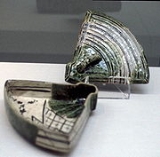
Japanese pottery
Overview
Japanese pottery and porcelain (陶磁器, Jp. tojiki; also 焼きもの, Jp. yakimono; 陶芸, Jp. tōgei), one of the country's oldest art forms, dates back to the Neolithic
Neolithic
The Neolithic Age, Era, or Period, or New Stone Age, was a period in the development of human technology, beginning about 9500 BC in some parts of the Middle East, and later in other parts of the world. It is traditionally considered as the last part of the Stone Age...
period. Kilns have produced earthenware
Earthenware
Earthenware is a common ceramic material, which is used extensively for pottery tableware and decorative objects.-Types of earthenware:Although body formulations vary between countries and even between individual makers, a generic composition is 25% ball clay, 28% kaolin, 32% quartz, and 15%...
, pottery
Pottery
Pottery is the material from which the potteryware is made, of which major types include earthenware, stoneware and porcelain. The place where such wares are made is also called a pottery . Pottery also refers to the art or craft of the potter or the manufacture of pottery...
, stoneware
Stoneware
Stoneware is a vitreous or semi-vitreous ceramic ware with a fine texture. Stoneware is made from clay that is then fired in a kiln, whether by an artisan to make homeware, or in an industrial kiln for mass-produced or specialty products...
, glazed
Ceramic glaze
Glaze is a layer or coating of a vitreous substance which has been fired to fuse to a ceramic object to color, decorate, strengthen or waterproof it.-Use:...
pottery, glazed stoneware, porcelain
Porcelain
Porcelain is a ceramic material made by heating raw materials, generally including clay in the form of kaolin, in a kiln to temperatures between and...
, and blue-and-white ware.
Japanese ceramic history records distinguished many potter names, and some were artist-potters, e.g., Honami Koetsu
Honami Koetsu
was a Japanese craftsman, potter, lacquerer, and calligrapher, whose work is generally considered to have inspired the founding of the Rinpa school of painting.-Early life:...
, Ogata Kenzan
Ogata Kenzan
, originally , and also known by the pseudonym Shisui, was a Japanese potter and painter, a younger brother of Ogata Korin. He was born in Kyoto in a rich marchant family and died in Edo . He had learned after the famous potter NONOMURA NINNSEI and made his own kiln. Since in 1712 a nobleman...
, and Aoki Mokubei. Japanese anonymous kilns also have flourished through the ages, and their influence weighs with that of the potters.

